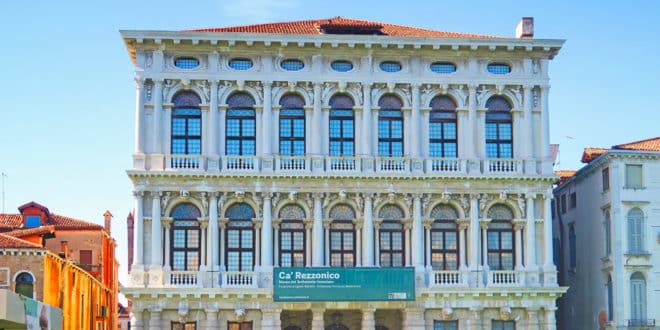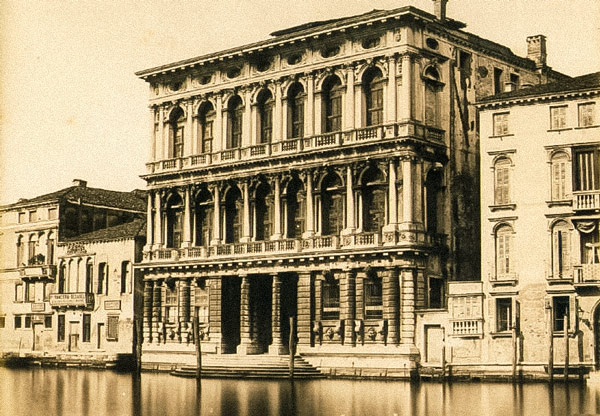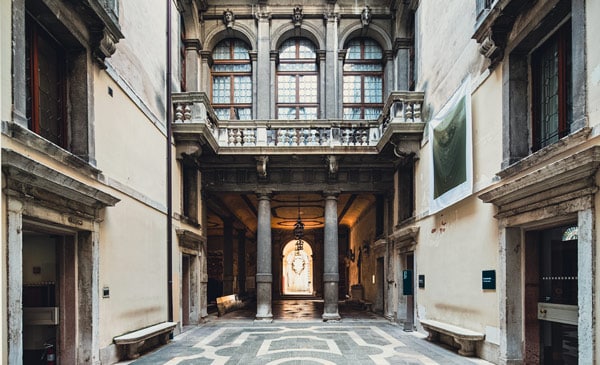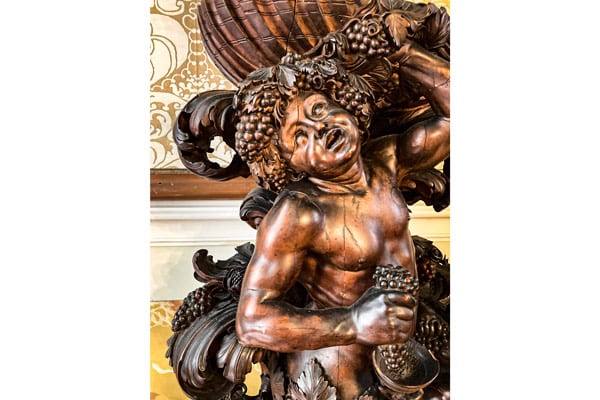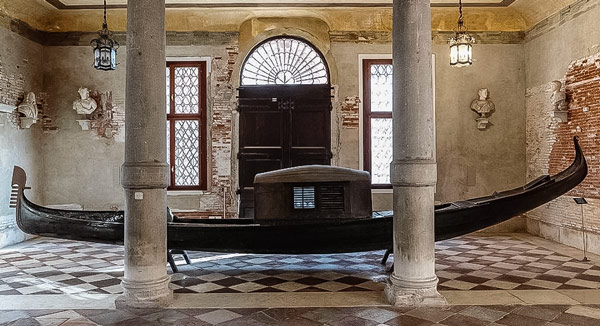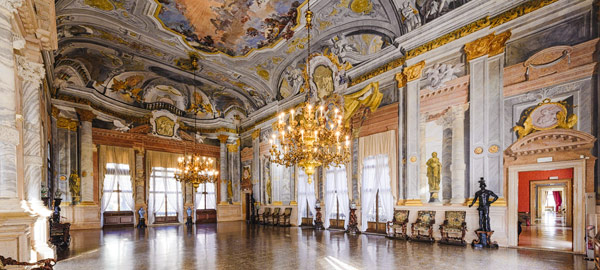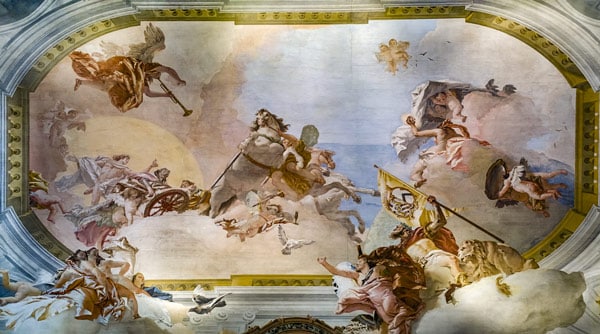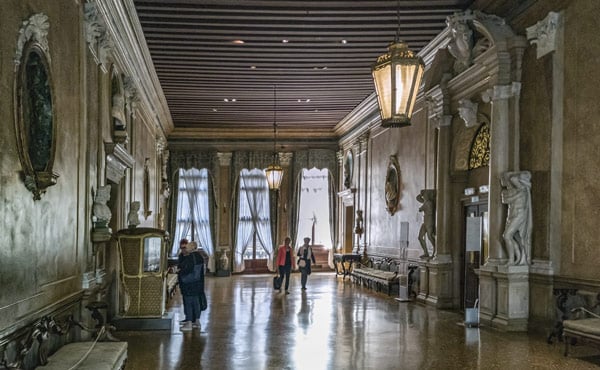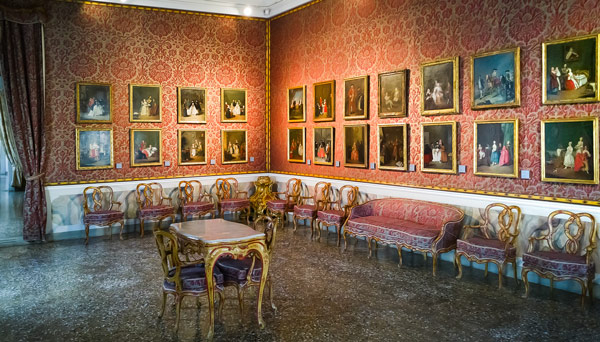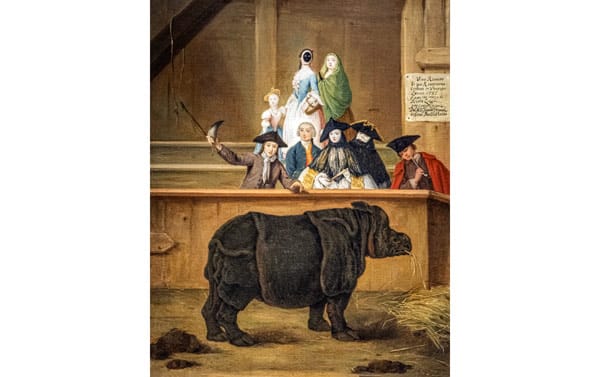The Palazzo Ca’ Rezzonico is a splendid example of Baroque architecture, and the Museo del Settecento Veneziano (Museum of Eighteenth-Century Venetian Art).
The name of the palace is derived from the abbreviated word caza (house) and the name of the aristocrat who owned the property at the time of its completion.
This ancient Palazzo, with a façade facing the Grand Canal, is located in the Dorsoduro district between Palazzo Contarini Michiel and Palazzo Bernardo Nani Lucheschi.
The location, architecture, sumptuous interior, and the value of the numerous art exhibits have placed Ca’ Rezzonico among the best museums in Venice.
Page Contents
History of Ca’ Rezzonico
The history of Ca’ Rezzonico echoes in many ways the history of the other palazzos in Venice. It was the embodiment of the designs of two great architects, passed from one owner to another, and had a period of prosperity and decline until it was reborn in the 20th century as a public municipal museum.
The Bon family
In the 15th century on the site of Palazzo Ca Rezzonico stood two houses belonging to the ancient aristocratic family of Bon. In a painting from 1500, the buildings still looked dignified among the structures on the right bank of the Grand Canal, but a century and a half later they were in a sorry state.
Filippo Bon, head of the family as procurator of St. Marko, planned to demolish the old buildings and build one large palace in their place. In 1649 he hired the most famous architect of the time, Baldassare Longhena, who decorated Venice with splendid baroque churches. Preparations took a long time, and construction of the facade did not begin until 1661.
The ambitious project remained incomplete, as the client failed financially, and the architect died in 1682. As a result, the construction of the Palazzo stopped at the noble floor, which for a long time remained simply covered with wooden beams. This is how the Palazzo is depicted (center left) in the 1726 painting “The Grand Canal: View North from the Rialto Bridge” by the vedunist artist Canaletto.
Interesting fact:
A famous member of the Bon family was Andrea Rustico da Torcello, the same one who in 828 participated in the theft of the relics of Saint Mark in Alexandria. A ninth-century mosaic recounting this event is in St. Mark’s Cathedral.
The Rezzonico family
In 1750, the Venetian nobleman Giovanni Battista della Torre di Rezzonico became the new owner of the unfinished Palazzo. He bought the property from the heirs of the impoverished Bon family for 60,000 ducats. It was an enormous sum at the time, but the cost was worth it. The prestigious location of the palace could not be better suited to the new high status of the owner.
The Rezzonico family, originally from the municipality of the same name in the province of Como, settled in Venice in 1640. She became rich in commerce and seized the opportunity to buy a title of nobility in 1687, in order to be included in the list of patrician families mentioned in the “Libro d’oro” (Golden Book). To do this she contributed 100 thousand ducats to the treasury of the Republic of Venice, when it was devastated after the war with the Turks.
Read also about Lake Como.
The construction of the family palazzo was to be completed as quickly as possible, as the building was already beginning to deteriorate. Giambattista Rezzonico hired the most fashionable architect of the time, Giorgio Massari, who had already built the Palazzo Grassi on the other side of the Grand Canal.
It took six years to complete and in 1756 the new palace had already opened its doors to visitors.
Also in 1776, Palazzo Rezzonico hosted the wedding celebrations of Ludovico Rezzonico and Faustina Savornian, uniting two of Venice’s most powerful families in marriage.
Decline of the Rezzonico family
The Rezzonico family line came to an end quickly, only 123 years after its appearance in Venice. The last male member of the family, Abbondio Rezzonico, who held the title of Senator of Rome at the time, died in 1810.
With the decline of the family’s power came the decline of the family palace. In the 19th century, it changed hands several times, losing its splendor.
The last owner of Ca Rezzonico was Count Lionello von Hirschel Minerbi, a member of the Italian parliament and a collector. He led a bohemian lifestyle, holding costume balls and concerts in Ca Rezzonico by candlelight and torches. This lasted until the Count went bankrupt. In 1935, after four years of negotiations, he sold the palace to the city.
Opening of the Museum of Venice within the walls of the Palazzo Ca Rezzonico
On April 25, 1936, the 18th-century Museum of Venice was opened within the walls of the Palazzo Ca’ Rezzonico. This decision was primarily due to the need to move some of the extensive collections from other museums in the city and above all from the Museo Correr.
The curators were faced with the difficult task of organizing the exhibition space, which was to become a Venetian temple of Seccheneto art – the end of the Renaissance and the beginning of the Baroque period.
The original interior of the Palazzo was completely missing when it was handed over to the city. The Pindemonte Rezzonico family sold all the furniture and art collections that once adorned the palace as early as 1832. The new interior was created from furniture, sculptures and paintings from other museums in Venice, as well as from items purchased at the antique market.
The first major restoration, begun in the late 1970s, was completed in 2001.
Here’s a list of what you can see for free in Venice.
Architecture
The main authorship of the design of Ca Rezzonico undoubtedly belongs to Baldassarre Longen, who introduced elements of novelty to the structure and decoration of the palace.
Features
Traditionally, the facade of a Venetian palazzo had a central part, highlighted by decorative windows, and two side wings. Baldassarre Longin broke the conventional rhythm and used a single architectural module for the entire surface. He repeated the technique he had already tried on the Procuranie Nuove, but enriched the marble façade of the Ca’ Rezzonico Palace with a splendid baroque decoration, creating a spectacular interplay of light and shadow.
The architect also prepared a surprise for the internal layout of the palace. Normally the two opposite entrances, on the Grand Canal and land side, were connected by a continuously covered gallery. At Ca Rezzonico, Longin broke it up with a rectangular-shaped courtyard, which brought light into the dark tunnel of the passage.
This open space, typical of terrestrial palaces, continued the theme of alternating dark and light areas, a scenic effect that the architect skillfully used in his designs.
At the end of the gallery, visitors’ eyes are drawn to the coat of arms of the Rezzonico family. It adorns a small fountain, immediately behind which is the Garden of Ca’ Rezzonico.
Facade
The façade of the Ca’ Rezzonico was completed by Giorgio Massari between 1750 and 1752, based on a design by Baldassarre Longhena. The rich decoration of white marble and the view of the Grand Canal indicated the high status of the palace’s owner and his financial wealth.
The facades of the two noble floors (piano nobile) on the second and third levels share the same architectural rhythm of decoration. It is formed by seven arched window spans, separated by pilasters and elegant balconies with a balustrade. There are expressive decorations in the Baroque style – lush capitals of the Corinthian order, floral rosettes, figures of putti, and decorative masks (mascarons) of female and male faces.
An interesting detail: if we look closely at the sculptures of plump babies above the arches of the windows, we can notice that none of them repeats the pose of the other.
The first level was traditionally used for the arrangement of household and secondary premises, including those intended for commercial purposes. Its facade is faced with rough stone (so-called rustication) and a more modest decorative finish. The three recessed bays in the center are decorated as the main entrance from the Grand Canal. The decorations on the lower floor are mascarons of male faces and lion heads. By the way, the animal faces have completely different expressions and are not repeated, nor are the putti on the upper floors.
The fourth level of the building is a mezzanine with small oval windows (perla baroca) decorated with a bas-relief with plant motifs.
The structure of the museum
The Museum of Eighteenth-Century Venice occupies the entire multi-layered space of Ca’ Rezzonico.
Visitors are greeted by the wide grand staircase of Giorgio Massari. Its decoration is the marble balustrade and two lovely statues-allegories “Winter” and “Autumn” by sculptor Giusto Le Court.
The museum’s main exhibition is displayed on two noble floors. In the exquisite interiors of these rooms, one can admire works of fine and decorative art of the 18th century – frescos, paintings, marble and wooden sculptures, fine furniture, Flemish tapestries, Venetian chandeliers, and mirrors.
The third floor is occupied by the Pharmacia Ai do San Marchi and the Art Gallery with 264 paintings donated to the museum by collector Egidio Martini.
The Pinacoteca includes paintings of the Venetian school from the 15th to the 20th centuries, including works by Boccaccio Boccaccino, Bonifacio Veronese, Jacopo Tintoretto, Alessandro Varotari, and other lesser-known but talented artists.
A staircase next to the café leads to the Browning Mezzanine. There is the Ferruccio Mestrovich Collection, consisting of paintings by famous artists of the 15th and 20th centuries: Jacopo Tintoretto, Guercino, Sebastiano Ricci, Giovanni Antonio Guardi, Jacopo Amigoni, and other masters of the brush.
In the portico of the first floor is exhibited the symbol of Venice – a large gondola of the XIX century. An interesting detail of its construction is the removable “felze” cabin. Until the XX century it was often installed on boats to protect passengers from the rain and prying eyes.
Read the article about gondolas and gondoliers in Venice.
Some cultural events organized by the Museum of Eighteenth-Century Art of Venice take place in the intimate Giardini di Ca’ Rezzonico with its fountain and statues. In the courtyard of the Palazzo, you can also relax without going into the museum, thanks to the benches and the coolness of the greenery.
The main rooms and works of the museum
The museum’s collections are grouped into rooms, which represent different thematic sections of the exhibition. Even a brief survey allows you to imagine the diversity and value of the exhibits in the Museum of Eighteenth-Century Venetian Art.
Ballroom
The ballroom (Salone da Ballo) on the first noble floor (primo piano) was designed by Giorgio Massari, as was the grand staircase.
This room, measuring 14×24 meters and two floors high, is considered the most beautiful and impressive in Venice! In the Ballroom the original decor has been preserved: the illusionary decoration of the walls by Gerolamo Mengozzi-Colonna, the ceiling fresco “Apollo’s Chariot” by Giambattista Crosato and two grandiose chandeliers of wood and gilded metal.
The splendid pieces of furniture along the walls were made by the brilliant sculptor and woodcarver Andrea Brustolon, whom Honoré de Balzac called “the Michelangelo of wood”. The Palazzo houses some 40 works by this master, including a separate Sala del Brustolon that displays figures of Ethiopian slaves and warriors, vase stands, armchairs, statuettes, and other masterpieces of wood sculpture.
Marriage Allegory Salon
The name of the Salone dell’Allegoria Nuziale was given by the ceiling fresco painted in 1757 by Giambattista Tiepolo and Girolamo Mengozzi in just 12 days.
It was dedicated to the wedding of representatives of two influential Venetian families – Ludovico Rezzonico and Faustina Savornian, whose images are depicted in the ceiling painting. The couple are seated in a solar chariot driven by Apollo, surrounded by allegorical figures – Cupid with his eyes blindfolded, Grazia sitting on a cloud, Truth with the sun in his hands, and other images.
In the same room are portraits of two other prominent members of the Rezzonico family – Carlo, son of Giambattista, the first owner of the palace, and Ludovico, known as Clement XIII. The paintings were painted by Anton Raphael Mengs, a German painter of the Neoclassical period.
Portego
The Portego, which served as the reception room, is the largest room of the second floor and the link between the main staircase and the piano nobile rooms.
Here, on the red marble walls, are a number of busts of important figures and allegorical figures. The work is by sculptors from the 17th and 18th centuries, including Filippo Parodi, Giusto Le Court, Alessandro Vittoria, and Giuseppe Torretti.
The attention of visitors is always attracted by the work of Giusto Le Court “Envy”. The sculptor presented an allegory in the form of an angry old woman with a dried-up body and snakes instead of hair.
The stark contrast to this work is the magnificent bust of the languid Lucrezia by the Genoese sculptor Filippo Parodi.
The story of the pious Roman woman who killed herself with a dagger after being raped by Tarquinius the Proud, the last king of Rome, has given rise to many works of fiction and literature, including this statue.
Antonio Guardi’s Room
The wall frescoes that decorated one of the rooms of the second noble floor (secondo piano) are the only work of their kind by the Italian artist Antonio Guardi. They were discovered under a layer of plaster in 1936 during the restoration of the Palazzo Barbarigo Dabalà and were later carefully transferred to Ca’ Rezzonico. Three small frescoes in oval frames in stucco depict the bellicose Minerva seated in the clouds, Apollo topped with a laurel wreath and Venus in company with Cupid in front of the forge of Vulcan.
The marble bust of the Veiled Lady (1772), a masterpiece by sculptor Antonio Corradini, deserves particular attention.
He mastered the technique of creating a transparent veil of marble that covers the face and figure of a woman. The secrets of transferring the finest layer of drapery were known in ancient Greece. Eighteenth-century masters were the last sculptors to grasp the secrets of the ancient sculptors’ craftsmanship, which had now been lost.
Longuey Hall
The exhibition in the Sala Longhi, the central long room of the third floor, allows you to sample the daily life of Venetian aristocrats. A series of paintings by the 18th-century Italian painter Pietro Longhi, a master of genre scenes and a talented rococo painter, are on display here.
It is extremely interesting to look at the faces and details of the costumes of the characters, the antique interiors of houses, scenes of family and town celebrations, episodes of everyday life, and other captured moments from the life of Venetians. The titles of the paintings already intrigue with their unusual subject matter: “The Charlatan,” “The Alchemists,” “The Giant Magrat,” “Morning Chocolate,” “The Mask Colloquium” and others. Each of them is not just an episode, but a whole story from the history of Venice.
The painting “Rhinoceros,” for example, shows that exotic animals were part of the entertainment rides during the three-month Carnival.
A female rhinoceros named “Clara” was brought from Bengal in 1751 and was shown by its owner at various festivals until her death in 1758. The painting is primarily a family portrait, depicting its customer, Girolamo Mocenigo, and his wife Caterina Contarini.
Portego Picture Gallery
The Picture gallery portego contains some of the most valuable paintings of the eighteenth-century Venice Museum of Art. These include two early works by Canaletto, “View of the Grand Canal from Ca’ Balbi toward the Rialto” and “Rio dei Mendicanti,” which are the only paintings by the artist that can be viewed in a public museum.
You can admire the views of Venice at night during the festival by looking at Gaspare Diziani’s unique painting, The Feast of St. Martha.
How to get there, tickets, and opening times
The Palazzo Ca Rezzonico is in the Dorsoduro area, at Dorsoduro, 3136, 30123 Venezia.
Nearby is the stop of the vaporetto N1.
Tickets cost 11 euros and can be purchased in advance online or at the ticket office.
Periodically, the Palazzo is closed for renovations, and the opening hours can be found on the official website carezzonico.visitmuve.it
Every room of Palazzo Ca Rezzonico, from the state rooms to the alcoves, offers visitors a unique opportunity to immerse themselves in 18th-century Venice, which is still full of surprises. The masterpieces of the Settecento period in the museum’s collection are a beautiful and final breath in the evolution of the great classical art of Italy.
 Italy for me From Italy with love
Italy for me From Italy with love

